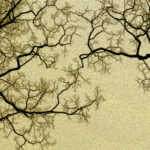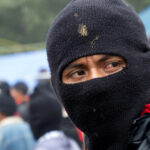Once I had read somewhere that Krishna played his flute to depict nature and seasons through music. It was also to elaborate the beauty of Radha, the symbol of nature. He could classify six seasons blaring out music through the (six) holes of a flute. There is a relation between nature and music that we find in ancient scriptures.
According to ‘Purana’ it is said that Siva, the pioneer of dance and drama once sang to resurrect the deformities of the ‘Swara’. The deformity of ‘Swara’ appeared due to Narada who sang discordantly. It was a difficult song that Shiva ever sang and there was no one except Vishnu to carry the load of his rhymes. Gradually Shiva began to sing and Vishnu began to sweat. He put it into his nectar which later became The Ganga. This story also indicates that music could even be a creater.
Apart from myth, history tells us about the magical power of music that Mia Tansen knew. It is said that Tansen had no equal apart from his teacher. Such was his passion for music that he is said to have performed astonishing miracles merely by singing. He could bring rain by singing in a particular Raag known as Megh Malhar. Similarly he could start a fire by singing in Raag Deepak. Other legends tell of his ability to bring wild animals to listen with attention (or to talk their language). Once, a wild white elephant was captured, but it was fierce and could not be tamed. Finally, Tansen sang to the elephant that calmed down and the emperor was able to ride him. Such was the power of his music that when he used to sing in the court of Akbar, it is said that candles used to light up automatically. Many aficionados are convinced that his death was caused by a conflagration while he was singing the raga Deepaka. He has also composed several Ragas that have been the foundation of classical music like Bhairav, Darbari Todi, Darbari Kanada, Malhar, Sarang and Rageshwari.
All such stories from ‘Purana’ or from History may be fictitious and modern science thus ignores mere folk stories. But we can draw instances from nineteenth century where Sri Muthuswamy Dikshitar (1775-1835), one of the most famous music maestros in Carnatic music achieved the bewitching power in music.
In Carnatic music Amruthavarshini is the raga that is supposed to get the rain. The raga Malhar is a powerful legendary in Hindustani classical music which is equivalent to Amruthavarshini. Even in Puranas, it’s written that in Thretayug, when Ravana set fire to Hanuman’s tail, he set fire to entire Lanka. Then Ravana played the Amruthavarshini raga on his Veena and brought forth rain. According to the legends, raga Malhar is so powerful that, when sung, it rains. The raga has lost its power among the ages because there was no one who could remember its complicated rhythms and beats. Many great artists of medieval period and much earlier period used to sing this raga. There are lots of miracles that have taken place and are still taking place by singing and chanting Ragas of Sri Muthuswamy Dikshitar. He attained mastery over the Veena, and the influence of Veena playing is evident in his compositions. Sri Dikshitar got the wonderful flow of music by the grace of Lord “Kumaraswamy”. Soon he began to sing in praise of the Lord in a unique style by singing a kriti “Anandamritha Varshini” in raga “Amruthavarshini”, he caused the thunderous clouds to gather over the sky and rain profusely when there were no rains in that region for one year and the people yearned for water. Once he was passing through the village Ettayapuram in thirunelveli District, there was an acute drought. Since he was well known for his powers, people in the village requested him to get rains in.

At their request he sang the same kriti in Amruthavarshini raga. When he sang the line “varshaya varshaya varshaya” it started raining heavily flooding the village and he had to sing the same song with the slight modification. Instead of “varshaya varshaya varshaya”, he used “sthambaya sthambaya” to stop the rains. There are many written accounts of the raga. Meera Bai, the devotee of Lord Krishna is among noble singers those who were capable of having down the rains by various kinds of raga Malhar. She has composed near about 1300 prayerful songs (bhajans), and most passionately praised Lord Krishna. It is also true that certain ragas cause certain reactions, such as Deepak raga. Infact someone went to the extent of saying that singing this raga could cause a burning sensation and that is why there are no songs that are taught in this raga.
Music has been used as a healing force for centuries. Music therapy goes back to biblical times, when David played the harp to rid King Saul of a bad spirit. As early as 400 B.C., Hippocrates, Greek father of medicine, played music for his mental patients. Aristotle described music as a force that purified the emotions. In the thirteenth century, Arab hospitals contained music-rooms for the benefit of the patients. In the United States, Native American medicine men often employed chants and dances as a method of healing patients. Music therapy as we know it began in the aftermath of World Wars I and II. Musicians would travel to hospitals, particularly in the United Kingdom, and play music for soldiers suffering from war-related emotional and physical trauma. Mozart piano sonata K448 there was a significant decrease in epileptiform activity as shown by the electroencephalogram (EEG). Some individual patients showed especially striking improvement. In one male, unconscious with status epilepticus, ictal patterns were present.
Greenhouse and field plants grow faster when soft music is played. Carefully controlled studies with plants showed that sound waves affect germination, growth, flowering, fruiting and seed yield, particularly by musical sounds ranging in the low frequencies from 100 Hz to 600 Hz. Cows also respond to music by giving more milk. Listening to music helps people relax, normalize blood pressure and balance moods. By listening to music at least once a day you can find and keep your inner balance.

So it is clear that music has a hidden power to heal and it is amazing that scientists are using this to serve their purpose especially in medical science without thinking that how it was possible to create a cordant tune by those people early as 400 B.C. Mystery remains forever. Cynic and pseudo scientists are in a fix. Mayans ‘played’ pyramids to make music for rain god, on the steps of Mexico’s El Castillo pyramid in Chichen Itza and you may hear a confusing sound. As other visitors climb the colossal staircase their footsteps begin to sound like raindrops falling into a bucket of water as they near the top. Were the Mayan temple builders trying to communicate with their Gods? It proves that there had been great findings to establish the relation between nature and music.
“Raga” is derived from the Sanskrit root “Ranja”, meaning to colour the mind with the sounds emanating from the cosmic vibratory Nada called “AUM” transmitting pranic energy. Technically speaking a raga is a sequence of notes or swaras which manifest of the universe both internal & external. But there is a lot more to this, as there are many characteristics required to establish the many fine features of any particular raga. Raga describes a generalised form of melodic practice.
The immense potential of the power of “Shabda” (cosmic flow of sound) hidden in music was well recognised by the ancient Indian sages and they had devised several musical patterns emanating from the “Omkara” for chanting of the Vedic hymns and for distinct spiritual effects. The Shastric schools of music discovered musical octave (sa, re, ga, ma, pa, dha, ni, sa) indwelling in the subtle sounds of Nature and invented the basic classical ragas for activating specific streams of natural powers and effects; a wide variety of musical compositions were generated consequently. Ever since then music has been an integral part of human culture with varied applications and forms. Despite its degeneration into the noisy and destructive kinds of so-called ‘modern music’, the creative and soothing role of music has not lost its prominence. The last few decades have seen revival of classical Indian and western music in a big way through increasing interest of researchers in music therapy.
I think simply that music is of feelings. According to the dictionary music is having rhythm, melody, or harmony. But it’s really underestimated, more so than anyone actually realizes. Mythologically there were manthras, sung in a special modulation which creates, some vibration in atmosphere attracts rain clouds. After all weather forecasts are done on the basis of Low pressure in sea. Vibrations are also cause of pressure like ripples rechoheted in atmosphere. Thus music can be used for raining.
Many times during yagas while chanting vedas rain has fallen in the yagasala. Megavarshini raga is supposedly invites rain. But I think it needs a band of musicians to create some vibration in atmosphere spontaneously. Moreover we have to find out the proper beats of music we once inherited from the past. In modern physics the butterfly effect is a term used in chaos theory to describe how small changes to a seemingly unrelated thing or condition (also known as an initial condition) can affect large, complex systems.

The term comes from the suggestion that the flapping of a butterfly’s wings in South America could affect the weather in Texas, meaning that the tiniest influence on one part of a system can have a huge effect on another part. Taken more broadly, the butterfly effect is a way of describing how, unless all factors can be accounted for, large systems like the weather remain impossible to predict with total accuracy because there are too many unknown variables to track. I do not know whether it is possible or not. However, we need nothing but a thorough research as early as possible before its extinction into the mechanism of discordant modern music.
Images courtesy: pinterest.com




